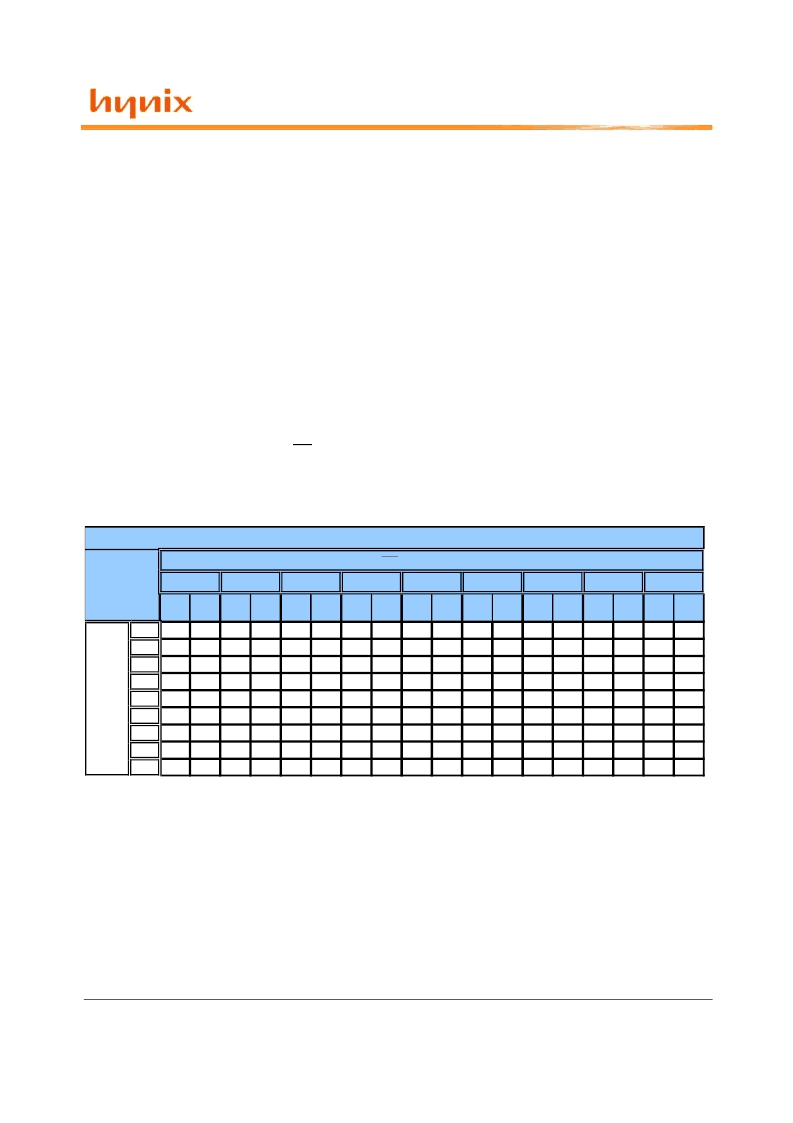- 您現(xiàn)在的位置:買賣IC網(wǎng) > PDF目錄385428 > HY5PS12421F (Hynix Semiconductor Inc.) 512Mb DDR2 SDRAM PDF資料下載
參數(shù)資料
| 型號: | HY5PS12421F |
| 廠商: | Hynix Semiconductor Inc. |
| 英文描述: | 512Mb DDR2 SDRAM |
| 中文描述: | 512Mb DDR2 SDRAM芯片 |
| 文件頁數(shù): | 26/35頁 |
| 文件大小: | 624K |
| 代理商: | HY5PS12421F |
第1頁第2頁第3頁第4頁第5頁第6頁第7頁第8頁第9頁第10頁第11頁第12頁第13頁第14頁第15頁第16頁第17頁第18頁第19頁第20頁第21頁第22頁第23頁第24頁第25頁當(dāng)前第26頁第27頁第28頁第29頁第30頁第31頁第32頁第33頁第34頁第35頁

Rev. 1.0 / Feb. 2005
26
1
HY5PS12421(L)F
HY5PS12821(L)F
HY5PS121621(L)F
Specific Notes for dedicated AC parameters
1. User can choose which active power down exit timing to use via MRS(bit 12). tXARD is expected to be
used for fast active power down exit timing. tXARDS is expected to be used for slow active power down
exit timing where a lower power value is defined by each vendor data sheet.
2. AL = Additive Latency
3. This is a minimum requirement. Minimum read to precharge timing is AL + BL/2 providing the tRTP and
tRAS(min) have been satisfied.
4. A minimum of two clocks (2 * tCK) is required irrespective of operating frequency
5. Timings are guaranteed with command/address input slew rate of 1.0 V/ns. See System Derating for
other slew rate values.
6. Timings are guaranteed with data, mask, and (DQS/RDQS in singled ended mode) input slew rate of 1.0
V/ns. See System Derating for other slew rate values.
7. Timings are guaranteed with CK/CK differential slew rate of 2.0 V/ns. Timings are guaranteed for DQS
signals with a differential slew rate of 2.0 V/ns in differential strobe mode and a slew rate of 1V/ns in single
ended mode. See System Derating for other slew rate values.
8. tDS and tDH derating
1) For all input signals the total tDS(setup time) and tDH(hold time) required is calculated by adding the datasheet value to the derating
value listed in Table x.
Setup(tDS) nominal slew rate for a rising signal is defined as the slew rate between the last crossing of VREF(dc) and the first crossing
of Vih(ac)min. Setup(tDS) nominal slew rate for a falling signal is defined as the slew rate between the last crossing of VREF(dc) and
the first crossing of Vil(ac)max. If the actual signal is always earlier than the nominal slew rate line between shaded ‘ VREF(dc) to ac
region’, use nominal slew rate for derating value(see Fig a.) If the actual signal is later than the nominal slew rate line anywhere
between shaded ‘VREF(dc) to ac region’, the slew rate of a tangent line to the actual signal from the ac level to dc level is used for
derating value(see Fig b.)
Hold(tDH) nominal slew rate for a rising signal is defined as the slew rate rate between the last crossing of Vil(dc) max and the first
crossing of VREF(dc). Hold (tDH) nominal slew rate for a falling signal is defined as the slew rate between the last crossing of Vih(dc)
min and the first crossing of VREF(dc). If the actual signal is earlier than the nominal slew rate line anywhere between shaded ‘dc to
VREF(dc) region’, the slew rate of a tangent line to the actual signal from the dc level to VREF(dc) level is used for derating value(see
△
tD
S
125
83
0
-
-
-
-
-
-
△
tD
H
45
21
0
-
-
-
-
-
-
△
tD
S
125
83
0
-11
-
-
-
-
-
△
tD
H
45
21
0
-14
-
-
-
-
-
△
tD
S
+125 +45
+83
0
-11
-25
-43
-67
-110 -125
-175 -188
△
tD
H
△
tD
S
-
95
12
1
-13
-31
-
-
-
△
tD
H
-
33
12
-2
-19
-42
-
-
-
△
tD
S
-
-
24
13
-1
-42
-43
-
-
△
tD
H
-
-
24
10
-7
-19
-59
-
-
△
tD
S
-
-
-
25
11
-7
-31
-74
-
△
tD
H
-
-
-
22
5
-8
-47
-89
-
△
tD
S
-
-
-
-
23
5
-19
-62
-127 -140 -115 -128 -103 -116
△
tD
H
-
-
-
-
17
-6
-35
-77
△
tD
S
-
-
-
-
-
17
-7
-50
△
tD
H
-
-
-
-
-
6
-23
-65
△
tD
S
-
-
-
-
-
-
5
-38
△
tD
H
-
-
-
-
-
-
-11
-53
2.0
1.5
1.0
0.9
0.8
0.7
0.6
0.5
0.4
+21
0
-14
-31
-54
-83
DQ
Slew
rate
V/ns
DQS, DQS
Differential Slew Rate
tDS, tDH Derating Values(ALL units in 'ps', Note 1 applies to entire Table)
1.6 V/ns
1.4 V/ns
1.2 V/ns
1.0 V/ns
4.0 V/ns
3.0 V/ns
2.0 V/ns
1.8 V/ns
0.8 V/ns
相關(guān)PDF資料 |
PDF描述 |
|---|---|
| HY5PS12421F-3 | 512Mb DDR2 SDRAM |
| HY5PS12421F-5 | 512Mb DDR2 SDRAM |
| HY5PS12421LF | 512Mb DDR2 SDRAM |
| HY5PS12421LF-3 | 512Mb DDR2 SDRAM |
| HY5PS12421LF-5 | 512Mb DDR2 SDRAM |
相關(guān)代理商/技術(shù)參數(shù) |
參數(shù)描述 |
|---|---|
| HY5PS12421F-3 | 制造商:HYNIX 制造商全稱:Hynix Semiconductor 功能描述:512Mb DDR2 SDRAM |
| HY5PS12421F-5 | 制造商:HYNIX 制造商全稱:Hynix Semiconductor 功能描述:512Mb DDR2 SDRAM |
| HY5PS12421F-E3 | 制造商:HYNIX 制造商全稱:Hynix Semiconductor 功能描述:512Mb DDR2 SDRAM |
| HY5PS12421FP | 制造商:HYNIX 制造商全稱:Hynix Semiconductor 功能描述:512Mb DDR2 SDRAM |
| HY5PS12421FP-X | 制造商:HYNIX 制造商全稱:Hynix Semiconductor 功能描述:512Mb DDR2 SDRAM |
發(fā)布緊急采購,3分鐘左右您將得到回復(fù)。